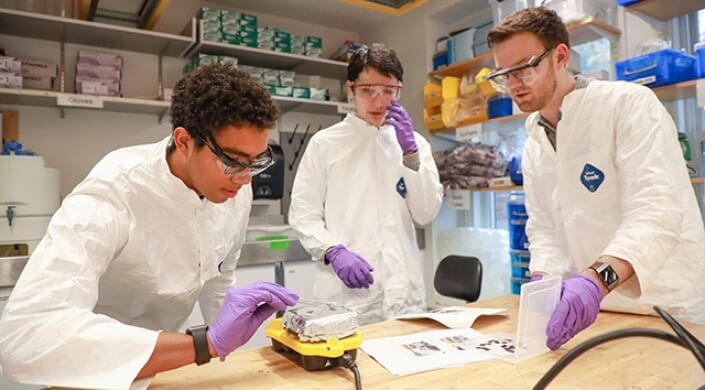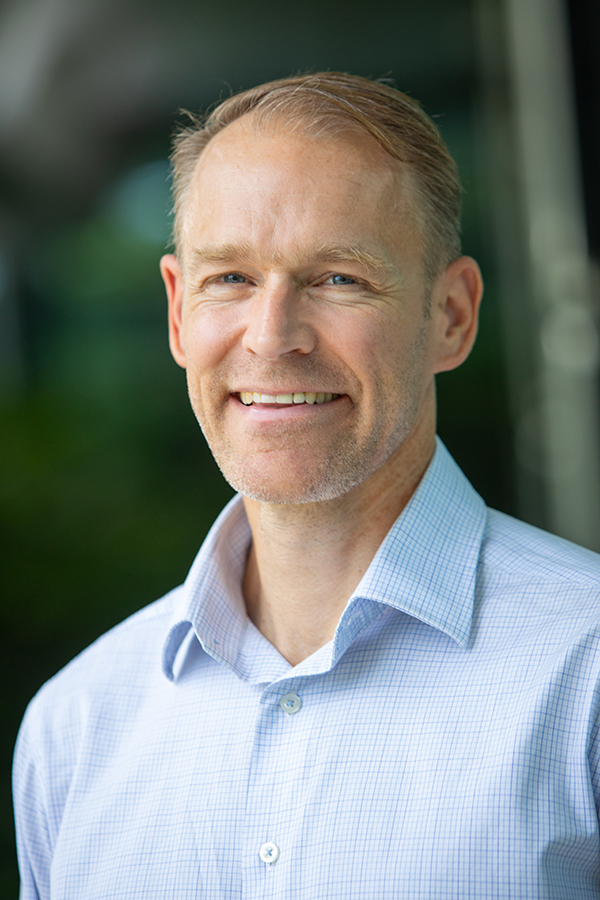News
Winston Michalak (left), S.B. ’21, an electrical engineering concentrator, uses a pair of tweezers to carefully manipulate a tiny, composite wafer during a lab for the newly redesigned course Circuits, Devices, and Transduction (ES 152.) (Photo by Eliza Grinnell/SEAS Communications)
Firmly grasping a pair of tweezers, the technician gingerly reached his hand forward and gently grabbed the edge of a tiny, composite wafer. He lowered a slender pipette over the tiny, black square and delicately placed one drop of red liquid directly onto the chip’s center.
He breathed a sigh of relief. . .just as the course instructor peeked over his shoulder to admire his work.
“I was really worried I was going to break that wafer as I manipulated it,” said the technician, Harvard undergrad Winston Michalak.
Michalak, S.B. ’21, an electrical engineering concentrator at the Harvard John A. Paulson School of Engineering and Applied Sciences, and his classmates in Circuits, Devices, and Transduction (ES 152) were etching composite wafers they will use to build LEDs, one of many hands-on labs conducted in the Active Learning Labs that are central to this newly redesigned course.
“Fabrication is pretty cool,” Michalak added, gesturing towards the tiny chip. “To be able to design things that are really efficient and so small is a very interesting subset of fields because it allows us to do so much. We are at the forefront of cutting edge research.”
Electrical engineering concentrators Dhilan Ramaprasad (left), S.B. '20, and Mikhail Grushko, S.B. '19, carefully drop red dye onto a composite wafer they used to build an LED in ES 152. (Photo by Eliza Grinnell/SEAS Communications)
ES 152, one of the core courses of the newly re-launched electrical engineering curriculum, is designed to marry theory and practice in a way that is both progressive and practical, said instructor Todd Zickler, William and Ami Kuan Danoff Professor of Electrical Engineering and Computer Science and Area Chair for Electrical Engineering.
Lectures and problem sets teach students to mathematically model analog devices and circuits, analyze them to predict their behavior, and design them, but there is less emphasis on memorization and more on implementation. Lab work is key—students put knowledge to the test by physically realizing their designs, taking measurements, and evaluating results.
“Since students can now access so many computational tools and so much information online, memorization and practicing calculations are much less important than they used to be,” Zickler said. “What is more important is to teach them how, given access to all of these tools, to decide which are the right ones for the job.”
For instance, students practiced circuit design by creating electrocardiograms, using sensors placed on their bodies and oscilloscopes to visualize their heartbeat.
Filtering out ambient noise was the biggest challenge Eric Jjemba faced as he adjusted his circuit to process the heartbeat signal.
“This lab is especially interesting because it is clearly relevant to people. The fact that we, as the human, are a part of the circuit is really cool,” said Jjemba, S.B. ’21, an electrical engineering concentrator. “I like how this course forces us to think critically and use theory to understand things we can’t even see, like electrons flowing through a circuit.”
Electrical engineering concentrator Eric Jjemba (right), S.B. '21, receives some tips on circuit design from ES 152 undergraduate teaching fellow Nicolas Weninger, S.B. '20, an electrical engineering concentrator. (Photo by Eliza Grinnell/SEAS Communications)
A few tables over, lab-mates and electrical engineering concentrators Daniela Villafuerte, S.B. ’21, and Katrina Gonzalez, S.B. ’21, leaned in over a laptop screen, studying the schematic for a low-pass filter so they could compare the values for resistors and capacitors to what they had built.
Troubleshooting circuits involves a lot of trial and error, said Villafuerte, who enrolled in ES 152 so she could better understand how circuits work.
“Outside of physics labs, I’ve never built a circuit before. It is really cool to see physics concepts apply to real things, like circuits, motors, or actuators,” she said. “To actually build something from scratch that could be used in the real world is really empowering.”
Electrical engineering concentrators Daniela Villafuerte (right), S.B. ’21, and Katrina Gonzalez, S.B. ’21, study the schematic for a low-pass filter during an ES 152 lab. (Photo by Eliza Grinnell/SEAS Communications)
Empowering students to be intuitive and creative, while drawing on key principles of electrical engineering, is one of the main goals of the curriculum re-launch, Zickler said.
ES 152 is one of a core set of five redesigned classes that cover all the fundamental components of electrical engineering, from building devices, to connecting devices into circuits, and then to creating and analyzing algorithms for computation, communication, sensing, or actuation. The courses offer an up-to-date view of how those topics apply to modern systems, such as the sensing and control mechanisms that help autonomous vehicles avoid crashes.
Whether they require students to make capacitive touch sensors, design RFID tags, or measure biological signals, the labs impart skills that are more than theoretical; they can be used to make a real impact on the physical world.
Months of planning and conversations went into the redesigned courses, Zickler said, with faculty ultimately asking the question—what should students know to be successful five or 10 years from now?
“Electrical engineering has contributed to some of the biggest societal transformations over the past 100 years, like wireless communication and silicon based computation,” Zickler said. “Right now, we are at the very beginning of another set of changes that is going to be just as profound, and very different, with things like the Internet of Things, autonomous vehicles, and renewable energy. We need to prepare students to be leaders of this next wave of electrical engineering.”
Topics: Academics, Electrical Engineering
Cutting-edge science delivered direct to your inbox.
Join the Harvard SEAS mailing list.
Scientist Profiles
Todd Zickler
William and Ami Kuan Danoff Professor of Electrical Engineering and Computer Science
Press Contact
Adam Zewe | 617-496-5878 | azewe@seas.harvard.edu




